Brineing vs marinating – which does what, how to use each method and when to use both.
Go straight to the Recipe Card for a Basic Brine recipe and a Basic Marinade recipe
Read on to understand how to use brines and marinades (2 min)
Brine vs Marinade
A brine and a marinade do two different things – the brine gives moisture while the marinade flavors.
Brines are perfect for lean cuts of meat such as poultry breasts. Marinades are better suited for proteins with good fat content for example marbled pork neck chops.
If you find yourself asking to brine or not to brine, usually the answer is that you should.
Our resident executive chef likes to say that most pork and all chicken and turkey cuts benefit from brining, not just the leanest cuts – so if you have the time you should consider doing it.
On the other hand only a few beef cuts, the toughest ones, should be treated with a brine because much of the natural juiciness and flavor of the beef can leach into the brine and be lost to the meat.
Brining Meaning
To brine means to soak a food in a saline solution to improve its texture and moisture content and to ultimately help it stay juicier during cooking.
A classic brine is a saturated solution of salt, sugar and water. Originally sea water was used to brine with the intent to preserve the food. The kind of brining we are concerned with here is a relatively modern technique and almost always includes sugar (and other ingredients) which add flavor to the food.
How a brine works:
Brining is a passive transport process at the molecular level. It is not the process of osmosis!!! Rather, through diffusion the water and the dissolved salt and sugar make their way into the food, flavoring it, increasing its water content and altering its protein structure.
The muscle fibers of meat have tightly wound proteins strands. The salt from the brine causes them to unwind which traps and retains water molecules. Ultimately during dry heat cooking methods there is a smaller loss of moisture and the food remains juicier.
TIP: An easy way to verify that your piece of meat has absorbed additional moisture from the brine is to weigh it prior to and after brining. The increased weight post soaking in a brine confirms the uptake of water.
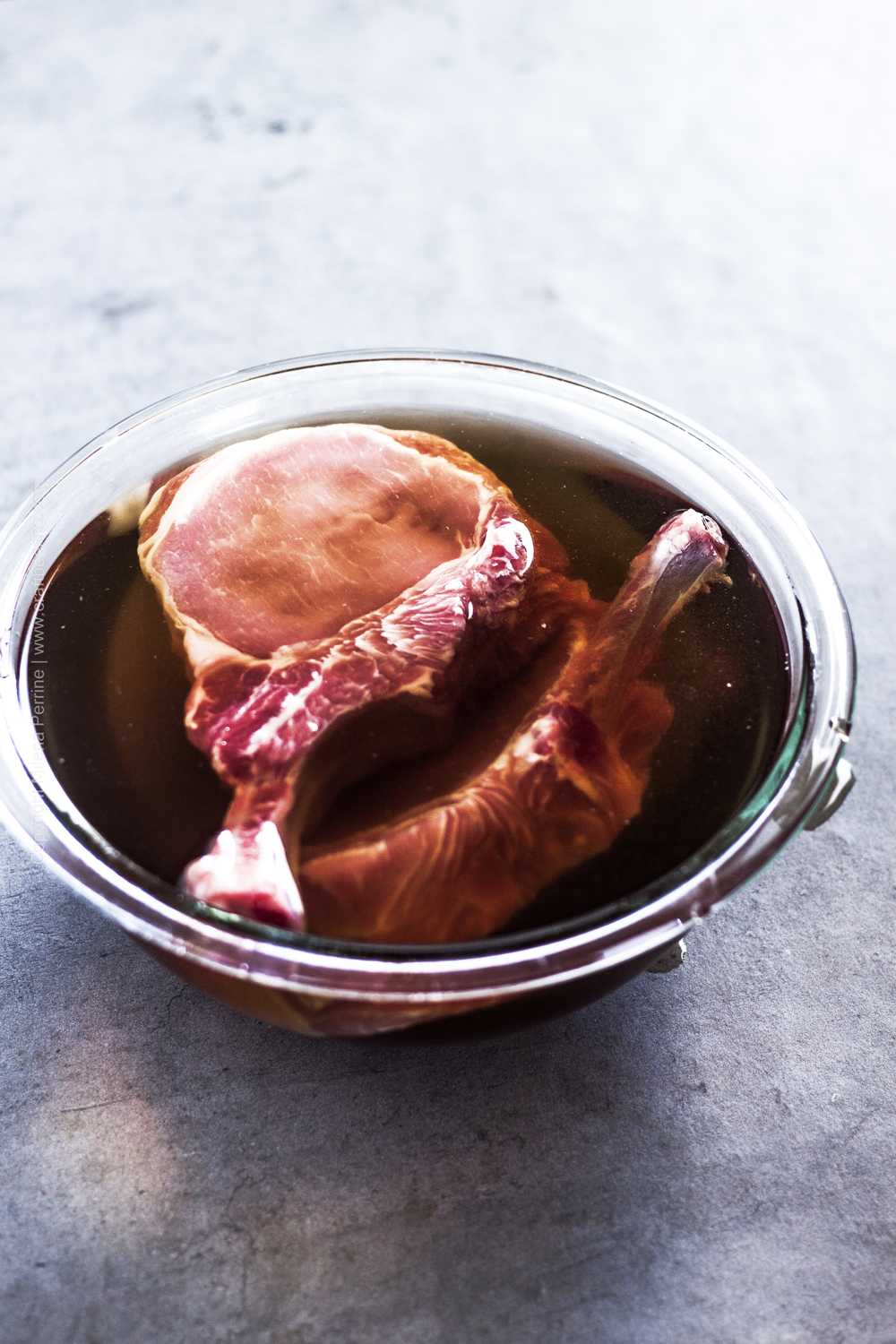
Thick pork chops in basic brine.
Basic Brine Recipe + How to Brine
Our formula for classic basic brine is 1 part kosher salt : 2 parts sugar : 16 parts water.
Typically, at work Chris makes it by the gallon(s), but for cooking at home we make a smaller amount which comfortably accommodates a whole chicken, two pork tenderloins, a few pork chops, etc. Feel free to scale it down even further if you’re only brining a pound of shrimp or two halibut fillets. We use 1/4 cup kosher salt, 1/2 cup brown sugar and 1 quart of water (pics above and below).
For larger pieces of food such as a whole turkey, whole fresh ham, whole pork loin you can make a stronger version of the brine, using more salt (ratio 1 1/2 parts kosher salt : 2 parts sugar : 16 parts water. Be mindful of the time your food will spend in this stronger saline solution to avoid disappointments (see time guidelines listed below).
NOTE: Use only kosher salt as it dissolves much faster. There is a difference between the two main brands, Morton and Diamond. Morton is dense and therefore a bit less of it is needed to achieve the same salinity. Increase the quantities above by 1/3 if using the Diamond brand.
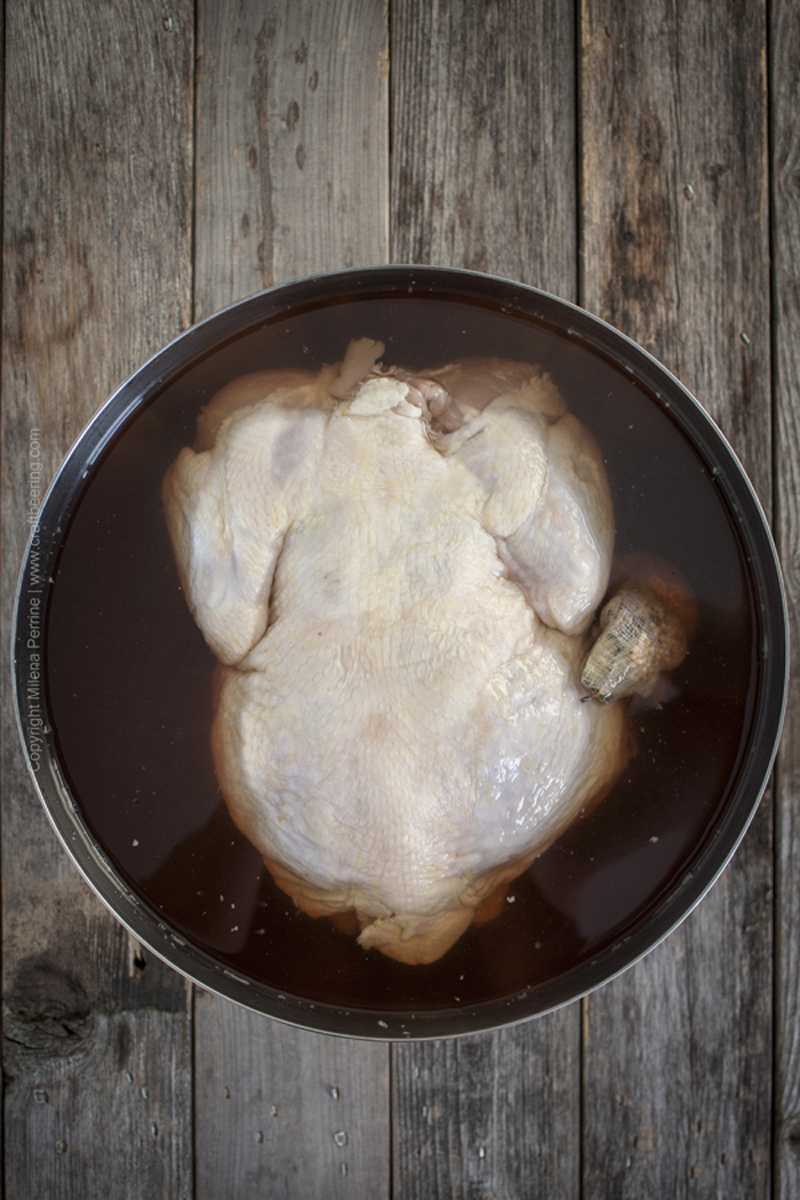
Whole chicken in flavored brine (peppercorns, bay leaf, garlic in bouquet garnie).
The following are important tips on how to brine:
- Before brining check the label to make sure that the food hasn’t already been brined or injected with a brine solution.
- To make the brine
- measure out a quarter of the total water needed and boil it with the salt and sugar until dissolved
- add it to the rest of the cold water (the rest of the water can be in the form of ice cubes) to dilute and cool down before immersing the food in the brine. If using ice cubes measure out a quantity a tad bit greater than what the water would have been.
- to turn a basic brine into a flavored brine add ingredients such as peppercorns, bay leaf, garlic, mustard seeds, etc.
- Fully submerge the food in the brine – on the case of whole chicken or turkey be sure to turn the bird over occasionally for even exposure.
- If you make more brine that you need to cover your food save the extra quantity in an airtight container, refrigerated.
- Brine for 30 minutes to 24 hours, depending on the weight of the food and its size (ex. 4 pounds of pork chops need less time than a 4 pound pork loin).
- less than 1 pound – 30 minutes
- 1 to 3 pounds – 45 to 60 minutes
- 3 to 5 pounds – 60 to 120 minutes
- 5 to 8 pounds – up to 6 hours
- over 8 pounds – 12 hours and up to 24 hours
- You can tell that moisture from the brine has been absorbed by the plumper look of the food (easier to see with smaller cuts than whole chickens or turkeys).
- Do not over brine, especially smaller foods like shrimp, because they can become too salty and actually dry out.
- Discard the used brine and let the food air dry. Do not rinse.
For using the flavors of craft beer in brines – consider our Basic Beer Brine Recipe (with Variations and Beer Style Recommendations).
Marinating Meaning
Marinating is to soak a food in a flavorful mixture of ingredients in order to impart desirable flavors to its surface.
Certain ingredients like enzymes found in fruit and yogurt can also tenderize the food to a certain extent if part of the marinade. This being said, its principal purpose is to flavor, not tenderize.
How a marinade works
A marinade is first and foremost a mixture of an oil with an acidic ingredient, along with spices, herbs and various other flavoring agents. It doesn’t penetrate deep into the food, rather it infuses its surface with the flavor of its ingredients.
Basic Marinade Recipe + How to Marinate
Our basic marinade formula is 3 parts fat : 1 part acid : all other ingredients to taste
The parts acid can be increased when the acidic ingredient is not too strong – for example beer, wine, cider, mustard, Worcestershire, mild vinegars such as apple cider or rice vinegar. When very acidic ingredients are used such as citrus juice, plain yogurt, or strong vinegars it is best to observe the ratio given above (too much acid turns the surface of meat mushy because it denatures the proteins).
- Always use a non-reactive container and be sure to cover all the surface area of the food with marinade.
- Always marinate food covered and refrigerated. This stops the meat from spoiling and prevents excessive bacterial growth.
- Do not re-purpose a used marinade as a basting liquid, glaze or extra sauce. To be food safe a used marinade needs to boil continuously for 3 minutes in order for any harmful bacteria from the meat’s surface to be killed. If you attempt to do this, say for example you decide to make a pan sauce with the used marinade, chances are that it will reduce too much and possibly burn before it can be deemed food safe. We recommend that you:
- Discard used marinades or use them solely to marinate the same type of protein.
- Reserve a small amount of the freshly mixed marinade or make half a batch extra to use as a glaze, basting liquid, etc.
Can I Brine and Then Marinate?
Yes, you can! If you brine meat and then marinate you can reap the benefits of each technique and cook juicy and flavorful proteins. Just be sure to not use salt in the marinade since the food will already absorb it from the brine.
For example if you are planning on grilling pork tenderloin first soak it in a basic brine. Because it is one of the leanest pork cuts grilling heat can leave it extremely dry – the brine will prevent this from happening. Then to flavor it mix a pork marinade, remove the tenderloin from the brine, and let it bathe in the marinade for a few hours before you cook it.
Resources You Might Find Useful
How to Brine Pork Chops
How to Brine Chicken for Smoking
Lamb Marinade Recipes
Pork Marinade Recipes
Beer Marinades for Chicken (Recipe Round Up)
Smoked Turkey Brine Recipe with Brown Sugar
Dark Beer Brine for Grilled Chicken
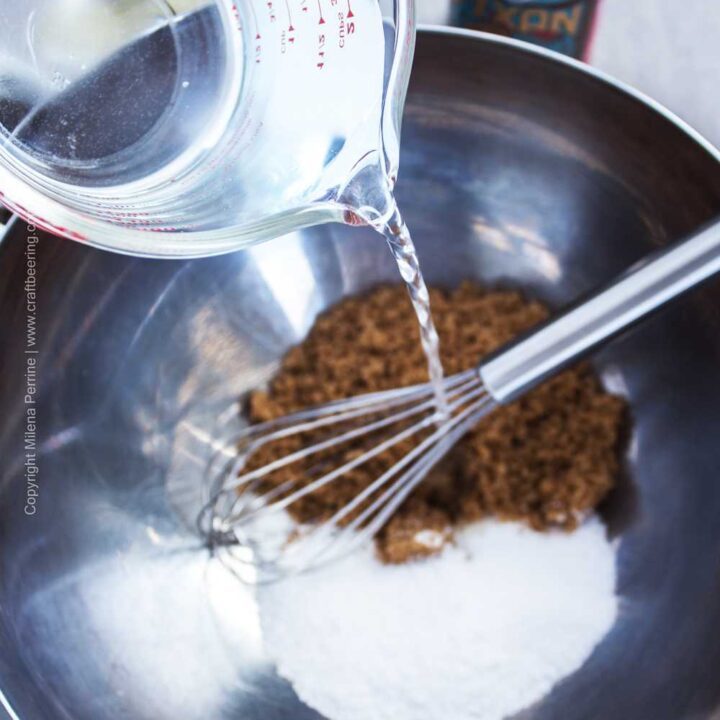
Brine or Marinate? Basic Recipes + Variation Tips
A basic brine formula and a basic marinade formula along with tips on how to customize and what to use each one for.
Ingredients
BASIC BRINE
- 1/4 cup kosher salt*
- 1/2 cup brown sugar
- 1 quart water**, divided
BASIC MARINADE
- 1/3 cup oil
- 2 tbsp acid***
- herbs, spices, sweeteners, emulsifiers (to taste)
Instructions
BASIC BRINE
Bring 2 cups of water to a boil, add the salt and sugar and stir to dissolve. Add the solution to the cold water to temper the temperature and let it cool down completely before you soak the food. (To make a flavored brine, add flavoring agents such as spices, herbs, spirits like bourbon, etc).
TIP: Alternative method: pour 2 cups boiling water over the salt and sugar, whisk to dissolve and add the rest of the 2 cups of cold water (or 2 1/2 cups of ice cubes), diluting the brine.
BASIC MARINADE
Whisk together all the ingredients.
Notes
HOW LONG TO BRINE FOR
The smaller, thinner and more delicate the cut of meat the less you will need to brine it for. For example thin pork chops can benefit even from a 2 hour soak. Larger cuts such as a whole turkey or a whole pork loin need much longer, 24 to 48 hours is common. Follow the instructions specific to the recipe you are using.
HOW LONG TO MARINATE FOR
It depends on the type of food being marinated and its size. The precise acidity content of the marinade also matters as acid can make meats mushy over prolonged time. While a fish fillet may only need 4 hours of marinating time, a leg of lamb will do better overnight. Adhere to the recipe specific instructions for the food you are preparing.
*If using Morton salt stick with the specified quantity. If using Diamond, increase by about 30 percent to get the same salinity.
** You can divide this quantity into 2 cups water and 2 1/2 cups of ice cubes.
***You can use more if the acid is mild (for example 1/4 cup beer or wine, 3-4 tbsp ACV or rice vinegar)
NUTRITIONAL INFORMATION is not provided as the brines and marinades are not consumed.

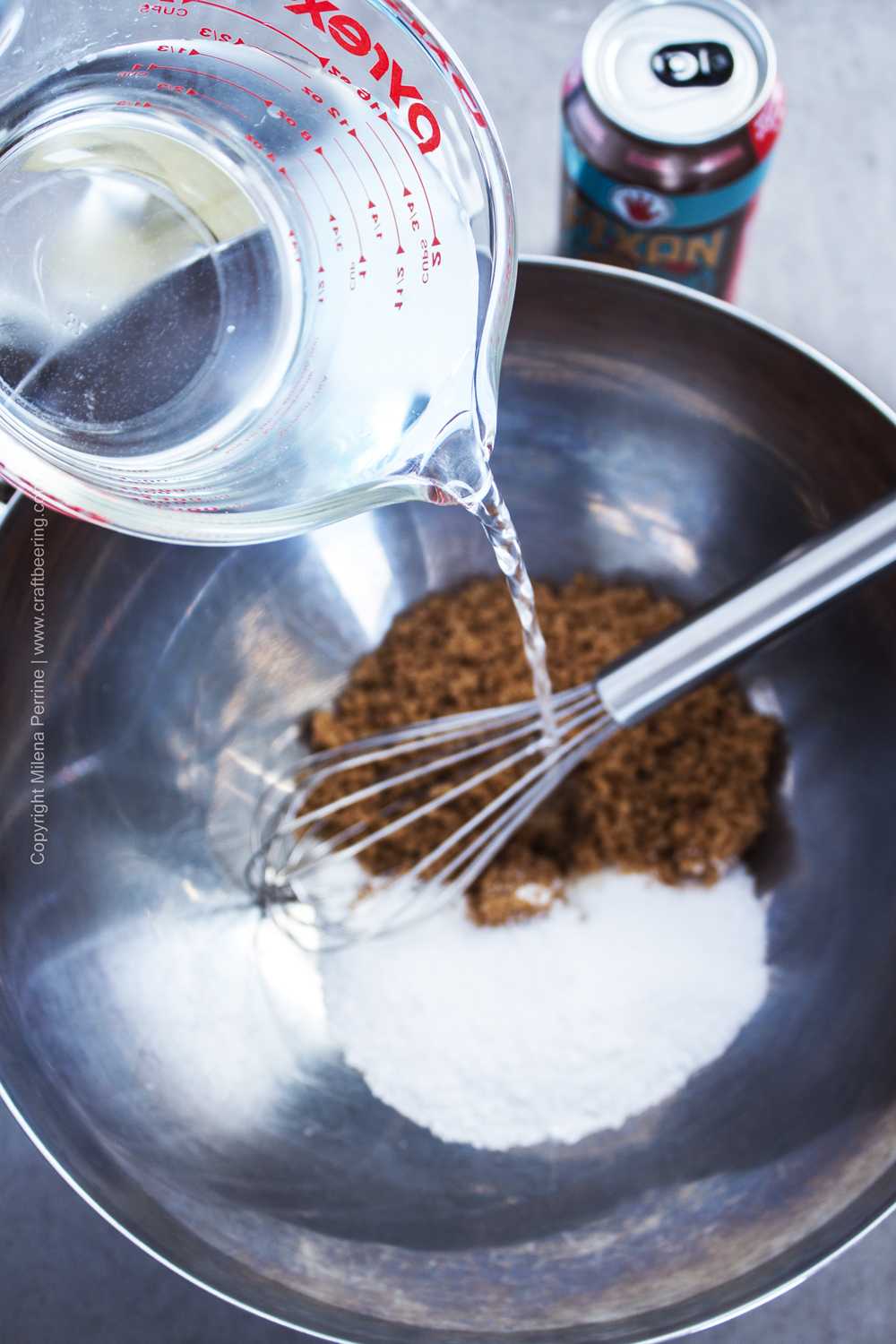
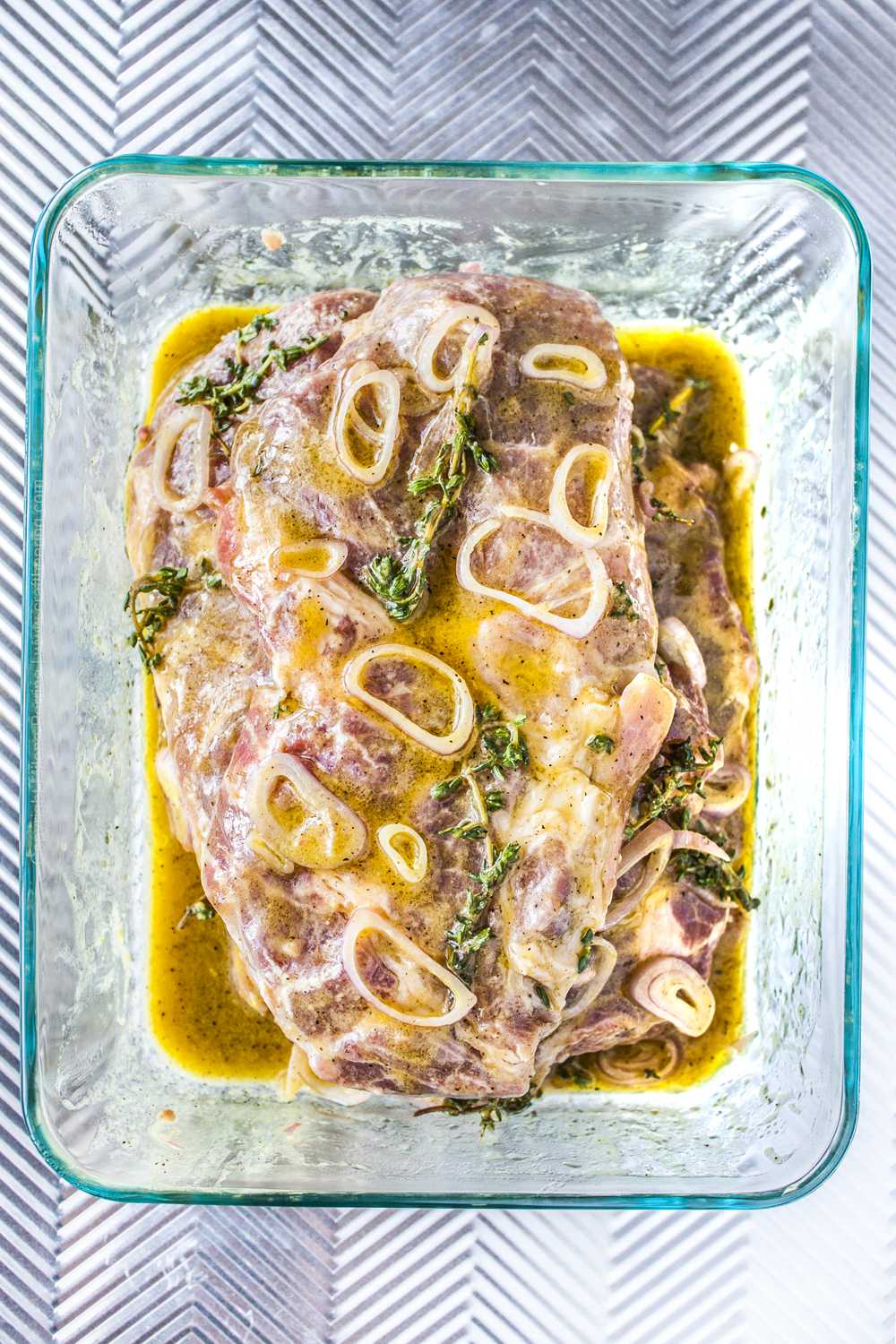
Mwamba says
Thank you very for this article I have really learnt alot. This is what I was longing for to learn about brining and marinating.
Stef says
Thank you for this interesting article concerning two methods often confused
You made all clear .
Craft Beering says
Thank you for taking the time to comment, Stef!
Md Redoy Hossain says
I really appreciate this article. I’ve found it useful. Thanks for sharing.
Katherine | Love In My Oven says
This is such a GREAT resource, Milena. I’m bookmarking it for later! I’m not very educated on brining and marinating and often wonder about it so now I know! Super helpful!
Jennifer @ Seasons and Suppers says
Such a helpful post! I feel as I have so much still to learn about how to bring out the best of all the meats and poultry, so I appreciate this 🙂
Kelsie | the itsy-bitsy kitchen says
This is so interesting and so helpful! I never really knew the difference, let alone when to use one versus the other!